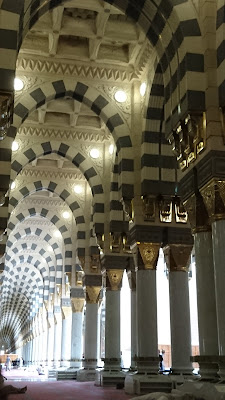 |
| (Big Bus hop-on hop-off city tour of Muscat) |
After our Umrah trip to the holy lands, we transited for about nine hour in Muscat, the capital city of Oman. During our half-day tour, I found Muscat city fascinating and lovely in general. The locals we met were friendly. Some local folks who could not speak English were shy but graciously charming. The scenery was spectacular and the food was delicious. It was not cheap though.
 |
| (Taking the early morning flight out of Jeddah) |
 |
| (The new and modern Muscat International Airport) |
Muscat is Oman’s port capital, sits on the Gulf of Oman surrounded by mountains and desert. With history dating back to antiquity, it mixes high-rises and upscale shopping malls with clifftop landmarks such as the 16th-century Portuguese forts, Al Jalali and Mirani, looming over Muscat Harbor.
 |
| (Welcome to Muscat! Our first visit here) |
 |
| (The majestic Sultan Qaboos Grand Mosque) |
 |
| (The 90 meter main minaret of the Grand Mosque) |
 |
| (Beautifully decorated main prayer hall) |
After a hearty lunch we visited the souk for souvenir shopping. The Muttrah Souq is perhaps one of the oldest marketplaces in the Arab world. It is located adjacent to the harbour of Muscat and has seen immense trade in the age of sail, being strategically located on the way to India and China. It has been named Al Dhalam Souq or Dark Market because of the crowded stalls and lanes where the sunrays do not infiltrate during the day. Shops selling Omani and Indian artefacts together with a few antiques jostle among more traditional textile, hardware and jewellery stores. Bargaining is expected.
 |
| (A sculpture dedicated to Omani culture) |
 |
| (This Muttrah area is touristically popular) |
 |
| (The entrance of the Mutrah Souq) |
 |
| (Buying local handicrafts and souvenirs) |
 |
| (My favorite souvenirs for family and friends) |
While waiting for our bus, we strolled around the Mutrah area. Mutrah stretches along an attractive corniche of latticed buildings and mosques. There are pristine gardens and fountains along this stretch. It looks spectacular at sunset when the light casts shadows across the serrated crescent of mountains, while pavements, lights and fountains invite an evening stroll or a bike ride. It is a beautiful seaside walk. The curved waterside area offering paved paths and artistic shelters with the views of the water and mountains. The harbour is home to His Majesty's dhow, visiting cruise ships and assorted naval vessels.
 |
| (Kissing couple at the round-about) |
 |
| (A 3 km stretch of paved walkway) |
The Muscat's sheltered port was once named by Ptolemy as The Hidden Port. Around the port area we saw the familiar brown yellow liveried Big Bus, a Hop-On Hop-Off service for about RM300/pax. Tourists are offered a ten stop journey of Muscat's greatest landmarks with a choice of six languages of pre recorded commentary.
 |
| (Cruise ships docking at the harbor) |
Our last visit was to Al Alam Palace, one of the six royal residences of the ruling monarch, Sultan Qaboos. It has a history of over 200 years, built by Imam Sultan bin Ahmed the 7th direct grandfather of the current Sultan. The existing palace, which has a facade of gold and blue, was rebuilt as a royal residence in 1972. The inner grounds of the palace remain off-limits but visitors are permitted to stop near the gates and take photographs. Al Alam Palace is surrounded by the Mirani and Jalali Forts built in the 16th century by the Portuguese. The Palace is used for official functions.
Our flight was scheduled late at night. We had ample time in Muscat International Airport visiting duty free shops with the usual duty free offerings of branded goods plus local handicrafts and delicacies.
It was quite an empty flight from Muscat to KLIA.. When boarding was completed, we had our choices of seats...
(Ahoy! All aboard... Sinbad navigating the perilous waterways...)

















































